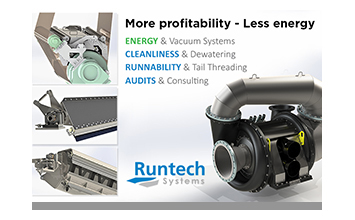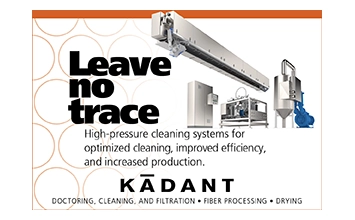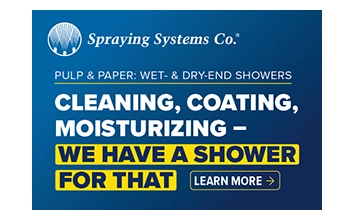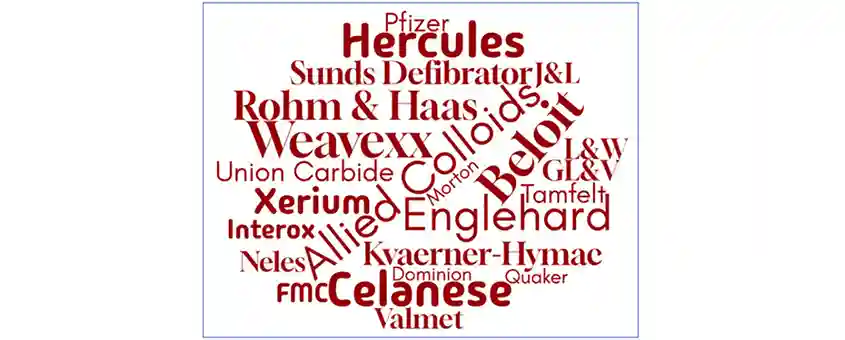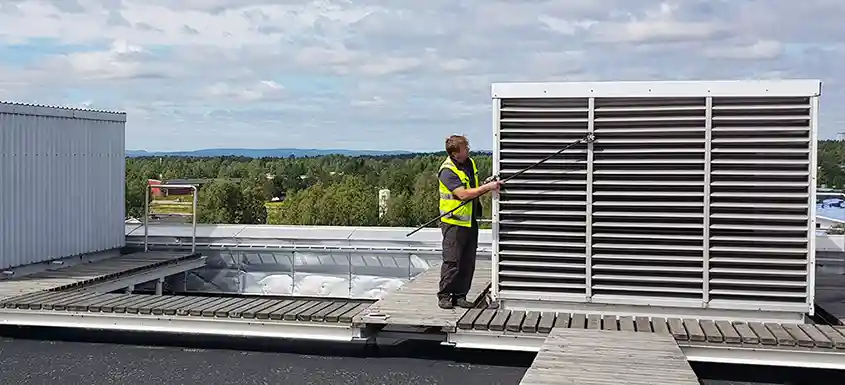It all starts with the nozzle. The nozzles on the showering systems in the Pulp and Paper industry are just like any other wear components.
They require the same level of attention and maintenance just like the doctor blades, roll bearings, and other components. Far too often have we heard mills say that if the shower is spraying, then everything is working great. However, this could not be further from the truth. This article will discuss ways to monitor your showers, nozzles, and spray patterns to ensure the best operation possible.
There are a lot of different factors when it comes to spray patterns and quality of spray. Things like laminar flow, turbulent flow, spray angle, spray pattern, pattern breakup, and visual appearance all help us decide when it could be time to change those existing nozzles out for new ones. You might find yourself asking why this matters. Why should I care about the wear of a spray nozzle? Well, for the different characteristics listed above, there are a lot of reasons. We’ll focus on a couple of the most used spray nozzle types in the paper industry, flat spray nozzles and solid stream nozzles.
Flat Spray Nozzles: Visual Indicators of Wear
While flat spray nozzles typically do not look too different to the untrained eye, there are a few things that can stand out when trying to decipher whether a flat spray nozzle is worn and ready to be changed. While there are obvious things that you may see on your system control screen like increased flow rate for a shower or variance in pressure, sometimes you will be able to notice changes in the spray quality itself. Instead of a uniform looking spray pattern, you may begin to notice streaks in the pattern. Streaks can disrupt the uniform coverage the nozzle provides and cause different sections the spray covers to receive different amounts of water. Typically, a normal flat spray nozzle will have a bell curve style distribution. The highest concentration in the center of the spray, with it tapering off as you get towards the outsides of the spray pattern. You can see below in Figure 1 the comparison between a good spray nozzle and a worn spray nozzle.
 Figure 1: Normal Flat Fan Spray Pattern vs. Worn Flat Fan Spray Pattern
Figure 1: Normal Flat Fan Spray Pattern vs. Worn Flat Fan Spray Pattern
The nozzle on the left has a nice, clean spray pattern and a nice even bell curve in the collection tubes which represent the spray distribution. The nozzle on the right has a very similar spray, but if you look closely, it has some slight streaks in the pattern. You can also notice below in the collection tubes that the spray distribution is not shaped like a clean, even bell curve. It produces much more spray in the center and the right side of the spray pattern. This can lead to uneven coatings and uneven spray impact which could lead to product quality issues if left unattended. This is not to mention also that if chemicals are being sprayed through these nozzles, you would be using excess chemical which can be very costly to waste.
 Figure 2: Close-up View of New Nozzle Spraying (left) vs. Worn Nozzle Spraying (right)
Figure 2: Close-up View of New Nozzle Spraying (left) vs. Worn Nozzle Spraying (right)
As Flat Fan nozzles continue to wear, you may also notice the spray angle begins to shrink and the edges become heavier. This is because the original precision-cut orifice has now changed shape. This will certainly happen more quickly when fluids that contain debris are sprayed through the nozzles. It is a well-known fact that many of the showers used in the papermaking process use recycled process water, or whitewater. This water contains debris that not only will clog the nozzles but will cause faster wear than a nozzle spraying clean and fresh water due to the added solids.
With all applications for our nozzles being different with different fluids being sprayed, solids content, operating pressures, flow rates, etc. it is impossible for us to give a generic statement for how long one of our nozzles should last. This is why it is important to pay attention to the spray characteristics noted above and work with your local spray experts to define a maintenance interval that works for your specific applications.
Solid Stream Nozzles: How to Spot Degrading Performance
Solid Stream nozzles can be more difficult to tell if they are worn. Generally speaking, the flow rate will not significantly increase. It will be the spray pattern which will show if a solid stream nozzle is worn or not.
Most solid stream nozzles within the paper industry are part of 2 different applications. One application is for trimming and tail cutting, the other is for HP Fabric cleaning. Both applications will use similarly sized, small orifices that will create a solid stream pattern. The typical orifice materials are 316 Stainless Steel, Ceramic, and Ruby/Sapphire. 316 Stainless Steel will have the shortest wear life whereas the Ruby/Sapphire orifices will have the longest wear life. The ceramic orifices will be somewhere in-between the stainless steel and the ruby. I mention these orifice materials because it is relevant to how the nozzle wears. Where the orifice diameter is, it is important for there to be a sharp edge where the water enters the orifice. When the edge is sharp, the nozzle will have a very good, clean spray. Ideally, the spray should have the resemblance to a “glass rod” without atomization or breakup. As this edge becomes more dull, the spray will begin to look less like a glass rod but will become more “white” and opaque in appearance. You will also notice the stream begins to breakup a shorter distance from the exit of the nozzle orifice. When this happens, you are significantly losing spray impact to these small water drops and particles. This can lead to inefficient fabric cleaning or poorly trimmed edges for a trimming application. Inefficient fabric cleaning can lead to things like non-uniform moisture profiles, quality issues, and higher energy operating costs. Poorly trimmed edges can have a very nasty effect and cause paper breaks on the machine. Poorly spraying trim nozzles are considered to be the number one cause of paper breaks on a paper machine.
 Figure 3: Solid Stream Nozzle with Glass Rod Spray Pattern
Figure 3: Solid Stream Nozzle with Glass Rod Spray Pattern
In Figure 3, you can see a good solid stream pattern. The water coming out of the orifice is round and looks just like a glass rod. It is almost difficult to see the spray pattern because of how crystal clear it is. In Figures 4 and 5 below, you will notice that the spray pattern is still somewhat clear, but you can see what looks like twisting occurring.
 Figure 4: Solid Stream pattern with angular exit and twisting
Figure 4: Solid Stream pattern with angular exit and twisting
 Figure 5: Solid Stream pattern with twisting occurring
Figure 5: Solid Stream pattern with twisting occurring
Figure 4 also shows the stream coming out of the nozzle is not co-linear with the nozzle. It is coming out at an angle which can cause the stream to not hit the intended target area. The twisting of the spray coming out can cause the pattern to be unstable and have unintended consequences during trimming operations.
 Figure 6: Solid Stream pattern with immediate breakup
Figure 6: Solid Stream pattern with immediate breakup
Figure 6 shows us a solid stream pattern that is exhibiting immediate breakup. When this happens, the nozzle loses much of its impact as tiny spray particles break off and take energy away from the main nozzle stream. This is important for both trimming and HP Fabric Cleaning applications as loss of impact can have serious effects on the paper making process. If your solid stream nozzles have these characteristics to them, it would be best to consult your local spray expert for an expert opinion on whether it is time to replace the nozzles or if they can continue to be used.
Establishing a Maintenance Routine
When it comes to nozzle maintenance, there is no doubt it can be a tedious task. However, it is a requirement to keep the production process in good shape. There are many showers and nozzles used within the papermaking process and there have been improvements over the years to help extend maintenance intervals, make maintenance easier, and help prevent nozzle clogging during normal operation.
The first step to help improve maintenance practices is to get an understanding of how well your showers and nozzles are currently spraying. If you do not currently have a planned nozzle replacement schedule, or you are just looking to improve your replacement schedule it is a good idea to note when the nozzles have been replaced on each shower and then follow up on following shutdowns to record their performance as time goes on. We typically consider a nozzle to be worth replacing when the flow rate has deviated by 10% or the spray angle has changed by 3 or more degrees for a flat fan type of nozzle. For solid stream nozzles, as discussed previously we need to pay attention to how the spray pattern appears during operation as the flow rate of the nozzles may not necessarily change. If the nozzle’s spray begins to atomize immediately, it is likely time to replace it.
To help extend time between maintenance intervals with shower nozzles, you can use a shower that has an integrated brush to clean the nozzles should you begin to notice spray pattern degradation or clogging. This can be taken a step further by using a shower that has an automated brush inside of it. This means the brush is operated by an electric motor and can be programmed to operate at pre-defined intervals. There are also ways to further automate this process with the use of sensors like pressure transducers and flowmeters. Brush type showers are very helpful when dirty water is used, like whitewater in the paper mills. The internal brush cleans the nozzles and inside of the pipe and the debris is washed away through a drain valve. This process can be done at any time, and the machine does not need to be stopped to cycle a brush type shower. Various nozzle materials can also help extend life between maintenance intervals by reducing the wear seen on a nozzle. Flat fan nozzles can use a variety of stainless steels, but also Tungsten Carbide. Solid stream nozzles can use orifice materials such as a variety of stainless steels, but also Ceramic and Ruby/Sapphire.
When it comes down to actually performing the maintenance task of replacing the nozzles, some can be easier than others to replace. A typical showerjet nozzle is a 3-component nozzle. There is the gasket, the nozzle disc itself, and then the retaining ring.
 Figure 7: A 3-piece Solid Stream Showerjet (left) compared to a One-Piece Solid Stream Showerjet (right)
Figure 7: A 3-piece Solid Stream Showerjet (left) compared to a One-Piece Solid Stream Showerjet (right)
 Figure 8: A 3-Piece Flat Fan Showerjet (left) and a One-Piece Flat Fan Showerjet (right)
Figure 8: A 3-Piece Flat Fan Showerjet (left) and a One-Piece Flat Fan Showerjet (right)
The one-piece showerjet design combines all these separate components into a single component making it much easier to change. Instead of fumbling with 3 separate components and making sure everything is in the correct order, the gasket is seated properly, and nozzle aligned, you could simply thread in a One-Piece showerjet and use the grooves provided on the front of the nozzle to properly align with the rest of the shower.
Another way to save time doing maintenance when changing shower nozzles is to use a quarter-turn locking nozzle tip style.
 Figure 9: QVVA and 58106-QVVA 1/4 Turn Locking QuickJet®️ Nozzles (Flat Spray)
Figure 9: QVVA and 58106-QVVA 1/4 Turn Locking QuickJet®️ Nozzles (Flat Spray)
These QuickJet®️ nozzles are a great way to reduce maintenance time. With just a quarter turn, the nozzle locks into position and you get the nozzle set at the correct offset angle every time. It can literally take just seconds to change a nozzle on a shower. It is common to see these style nozzles used for applications in Tissue making on the Yankee Dryer due to the criticality of that application. However, these nozzles could be used in just about any flat fan style nozzle application to save time during shutdowns.
With regards to showers, there are also ways to save time with maintenance. Showers often accumulate debris during normal operation in the paper industry. All the pulp, fiber, sludge, and debris can pile up on the showers making them difficult to remove from the machine itself, but also difficult to access and remove the nozzles requiring the entire shower to be washed down thoroughly. A way to combat this extra step is to use a pipe-in-pipe style shower. A pipe-in-pipe style shower is exactly what it sounds like. There is an outer pipe which becomes permanently mounted to the machine frame. On the outer pipe there is a slot with which the nozzles that are attached to the inner pipe spray through. The inner pipe has a liquid feed connection and all the nozzles to spray onto the target substrate. The inner pipe also has several supports mounted on it along with a positive key to ensure the pipe is secure inside the outer pipe and that it remains only in its proper spraying orientation. This makes it easy to slide the inner pipe out for maintenance of the nozzles, and the outer pipe also keeps the nozzles clear of debris making changing them a lot easier.
 Figure 10: Pipe-In-Pipe Shower Example
Figure 10: Pipe-In-Pipe Shower Example
An alternative way to make maintenance easier is to make sure the correct nozzle is selected for the right application. Things like water quality, accessibility, shower orientation, and more can affect which nozzle type should be used. It is a good idea to work with your local spray specialist to explain the situation and have them analyze to make sure you have the best nozzle and shower selected for your application. Spraying Systems Co has been around for over 85 years and has seen all the applications and how to choose the right products for the applications out there.
About the Author
Bernard Pyzdrowski is Project Engineer, Pulp & Paper Industries, at Spraying Systems Co.
About Spraying Systems
Spraying Systems Co. is the world’s leading manufacturer of spray nozzles. Every day, our local spray technology experts help customers optimize operations and create more sustainable manufacturing practices. With tens of thousands of standard products, we have the right nozzle for your application – and we ship most standard products in one day. If you need a special product or material, contact us! We develop hundreds of custom nozzles, injectors and headers every year. Our engineering and manufacturing resources can help solve your toughest spray technology challenges.











